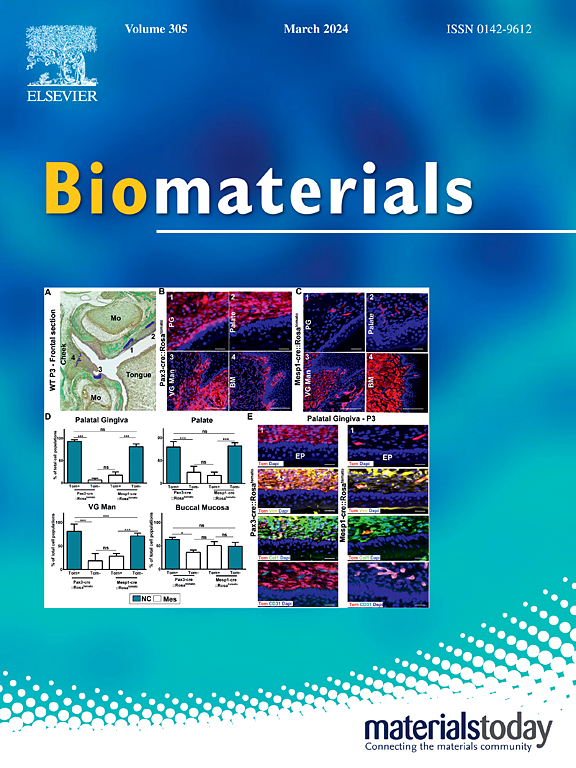An “all-in-one” therapeutic platform for programmed antibiosis, immunoregulation and neuroangiogenesis to accelerate diabetic wound healing
IF 12.8
1区 医学
Q1 ENGINEERING, BIOMEDICAL
引用次数: 0
Abstract
Pathological microenvironment of diabetes induces a high risk of bacterial invasion, aggressive inflammatory response, and hindered neuroangiogenesis, leading to retarded ulcer healing. To address this, an “all-in-one” therapeutic platform, named MZZ, was constructed by loading maltodextrin onto a MOF-on-MOF structure (with ZIF-67 as the core and ZIF-8 as the shell) through a hybrid process of solvent treatment and electrostatic adsorption. Maltodextrin acts as a target to bind surrounding bacteria, and ZIF-8 as well as ZIF-67 responsively release Zn and Co ions, which not only kill most bacteria, but also improve the phagocytosis and xenophagy of M1 macrophages by up-regulating the expression levels of ATG5, Bcl1 and FLT4, helping the residual bacterial clearance. In inflammatory stage, MZZ scavenges extracellular and intracellular ROS by valence transition between Co2+ and Co3+, and promote M1 macrophages to transform into M2 phenotype. In tissue reconstruction stage, the synergistic effect of Zn and Co ions as well as cytokines secreted by macrophages up-regulates cell vitality and biofunctions of endotheliocytes, neurocytes and fibroblasts. The programmed effects of MZZ on antibiosis, anti-inflammatory and neuroangiogenesis to accelerate wound repair are further confirmed in an infected diabetic model, and this “all-in-one” platform shows great clinical application potential.

一个“一体化”的治疗平台,程序抗生素,免疫调节和神经血管生成,以加速糖尿病伤口愈合
糖尿病的病理微环境导致细菌侵袭风险高,炎症反应侵袭性强,神经血管生成受阻,导致溃疡愈合迟缓。为了解决这一问题,通过溶剂处理和静电吸附的混合工艺,将麦芽糖糊精加载到MOF-on-MOF结构(以ZIF-67为核心,ZIF-8为壳)上,构建了一个名为MZZ的“一体化”治疗平台。麦芽糊精作为靶标与周围细菌结合,ZIF-8和ZIF-67响应性释放Zn和Co离子,不仅能杀死大部分细菌,还能通过上调ATG5、Bcl1和FLT4的表达水平,提高M1巨噬细胞的吞噬和异种吞噬能力,帮助清除残留细菌。在炎症期,MZZ通过Co2+和Co3+之间的价态转换清除细胞外和细胞内的ROS,促进M1型巨噬细胞向M2型转化。在组织重建阶段,Zn和Co离子与巨噬细胞分泌的细胞因子协同作用上调内皮细胞、神经细胞和成纤维细胞的细胞活力和生物功能。在感染型糖尿病模型中,MZZ对抗生素、抗炎和神经血管生成的程序化作用进一步得到证实,加速伤口修复,这种“一体机”平台具有很大的临床应用潜力。
本文章由计算机程序翻译,如有差异,请以英文原文为准。
求助全文
约1分钟内获得全文
求助全文
来源期刊

Biomaterials
工程技术-材料科学:生物材料
CiteScore
26.00
自引率
2.90%
发文量
565
审稿时长
46 days
期刊介绍:
Biomaterials is an international journal covering the science and clinical application of biomaterials. A biomaterial is now defined as a substance that has been engineered to take a form which, alone or as part of a complex system, is used to direct, by control of interactions with components of living systems, the course of any therapeutic or diagnostic procedure. It is the aim of the journal to provide a peer-reviewed forum for the publication of original papers and authoritative review and opinion papers dealing with the most important issues facing the use of biomaterials in clinical practice. The scope of the journal covers the wide range of physical, biological and chemical sciences that underpin the design of biomaterials and the clinical disciplines in which they are used. These sciences include polymer synthesis and characterization, drug and gene vector design, the biology of the host response, immunology and toxicology and self assembly at the nanoscale. Clinical applications include the therapies of medical technology and regenerative medicine in all clinical disciplines, and diagnostic systems that reply on innovative contrast and sensing agents. The journal is relevant to areas such as cancer diagnosis and therapy, implantable devices, drug delivery systems, gene vectors, bionanotechnology and tissue engineering.
 求助内容:
求助内容: 应助结果提醒方式:
应助结果提醒方式:


